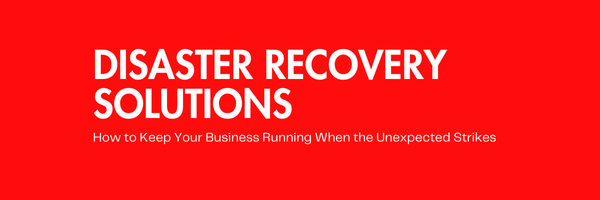Disaster Recovery Solutions: How to Keep Your Business Running When the Unexpected Strikes
Disasters don’t wait for a convenient time. Whether it’s a hurricane, power outage, cyberattack, or hardware failure, unexpected events can halt your business operations in minutes. While backups store your data, Disaster Recovery Solutions (DRS) ensure that your business can continue functioning during and after a crisis.
Understanding disaster recovery isn’t just an IT concern—it’s a business imperative. Many companies underestimate how quickly downtime can escalate costs, damage client trust, and threaten long-term survival.
The Stakes Are High
Even a brief disruption can have lasting consequences. Studies indicate that:
- 60% of businesses close within six months of a major data loss.
- The average cost of downtime ranges from $5,600 to $9,000 per minute, depending on industry and scale.
- Customer trust is fragile—clients are more likely to switch providers if services are interrupted.
The reality is clear: without a strong disaster recovery plan, businesses risk permanent closure.
What Disaster Recovery Really Means
Disaster Recovery is more than just restoring files. It’s a comprehensive strategy that enables businesses to resume critical operations quickly after a disruption. Core components include:
- Rapid Recovery Systems: Ensure minimal downtime so employees and clients can continue accessing services.
- Redundancy: Use onsite and offsite solutions to protect data and infrastructure.
- Tested Protocols: Predefined procedures reduce confusion during emergencies and speed up restoration.
- Flexible Infrastructure: Cloud-based solutions allow remote access and scalability, ensuring operations can continue from anywhere.
A good DRS plan transforms a potential catastrophe into a manageable disruption.
Common Disasters Businesses Face
Understanding potential threats helps shape an effective disaster recovery strategy. Common scenarios include:
- Natural Disasters: Hurricanes, floods, tornadoes, earthquakes, and storms can damage physical infrastructure and cause prolonged outages.
- Hardware Failures: Servers and networking equipment can fail unexpectedly, halting operations.
- Cybersecurity Attacks: Ransomware, malware, and phishing attacks can lock critical systems or destroy data.
- Human Error: Mistakes in configuration, accidental deletions, or operational oversights can lead to serious disruptions.
Each scenario requires a tailored response, highlighting the need for a robust, tested disaster recovery solution.
Key Features of an Effective Disaster Recovery Solution
To truly protect a business, a DRS must go beyond simple backups. The features that matter most include:
- Automated and Continuous Monitoring – Systems are constantly checked for failures or anomalies, allowing for immediate response.
- Rapid Data and System Restoration – Downtime is minimized with pre-configured recovery steps and failover mechanisms.
- Hybrid Storage Solutions – On-site recovery units provide speed, while cloud backups ensure off-site security.
- Regular Testing and Updates – Simulated disaster drills verify the plan works and identify gaps before a real disaster occurs.
- Scalability and Flexibility – The solution adapts to business growth and evolving IT requirements.
When these elements are combined, businesses can withstand disasters with confidence.
Steps Businesses Should Take Today
Even if your business hasn’t faced a disaster yet, preparation is critical:
- Assess Risks – Identify vulnerabilities in infrastructure, operations, and data management.
- Prioritize Critical Systems – Determine which systems and applications must remain operational during a disruption.
- Develop a Recovery Plan – Document step-by-step procedures for restoring operations.
- Implement the Right Solution – Choose a Disaster Recovery Solution that aligns with your business size, complexity, and risk profile.
- Test Regularly – Schedule simulations to ensure your plan works under pressure.
Being proactive can mean the difference between a minor disruption and a business-ending catastrophe.
How PC Works Tech Supports Businesses with Disaster Recovery
At PC Works Tech, our Disaster Recovery Solution is designed to protect small and midsize businesses from the unexpected. Key benefits include:
- Rapid Recovery: Systems can be restored in hours rather than days.
- Redundant Infrastructure: On-site and cloud-based failovers minimize downtime.
- Proven Protocols: Our tested processes ensure a swift, reliable response during any incident.
- Scalable Solutions: As your business grows, our disaster recovery adapts to changing needs.
By implementing a professional Disaster Recovery Solution, businesses not only protect data—they safeguard operations, employees, and client trust.
Conclusion
Disasters are unpredictable, but your business continuity doesn’t have to be. Investing in a dedicated Disaster Recovery Solution ensures that when the unexpected happens, your company can continue operating with minimal disruption. Planning ahead isn’t optional—it’s essential for long-term survival and success.
Learn more about PC Works Tech’s Disaster Recovery Solution:




No responses yet